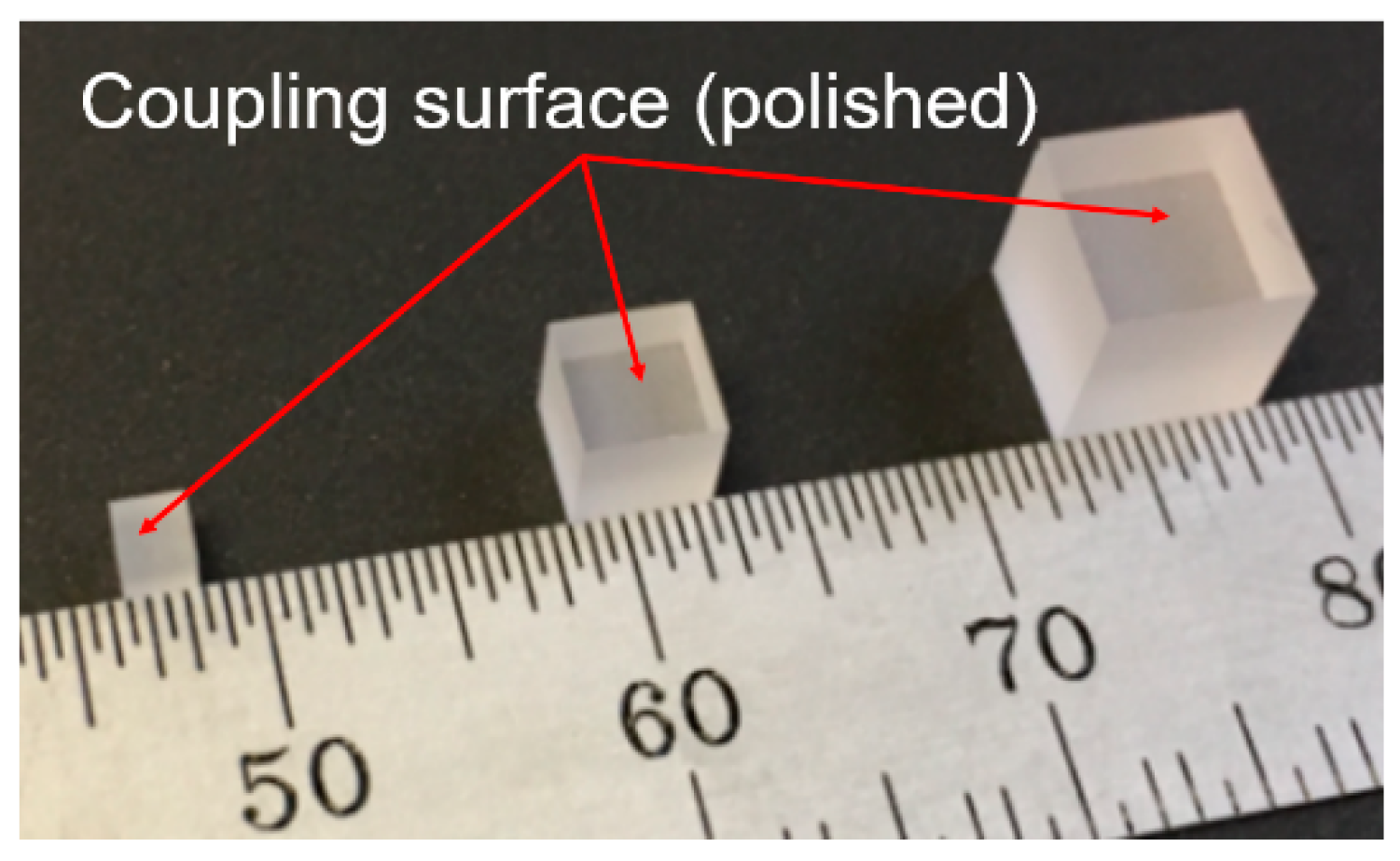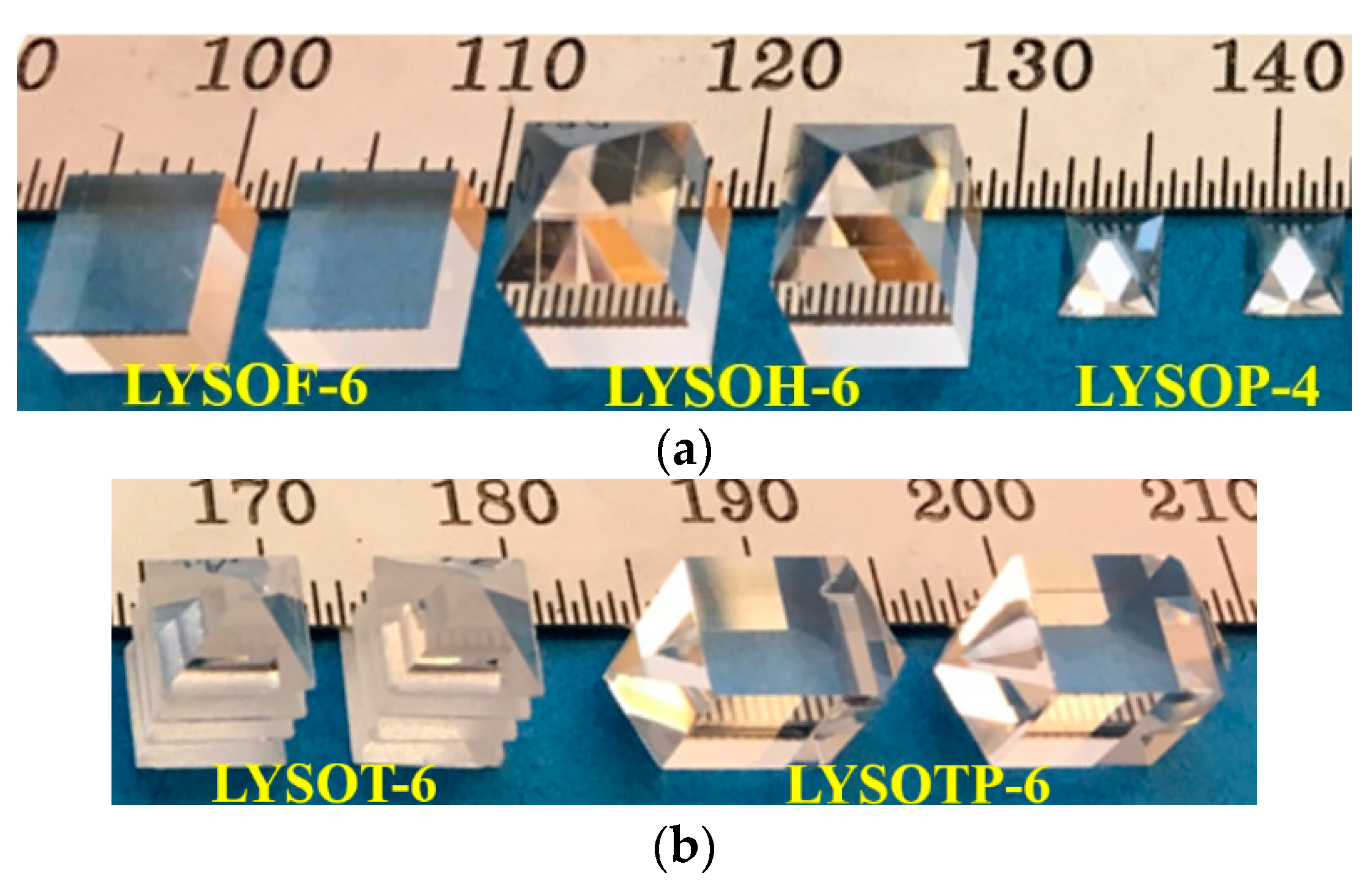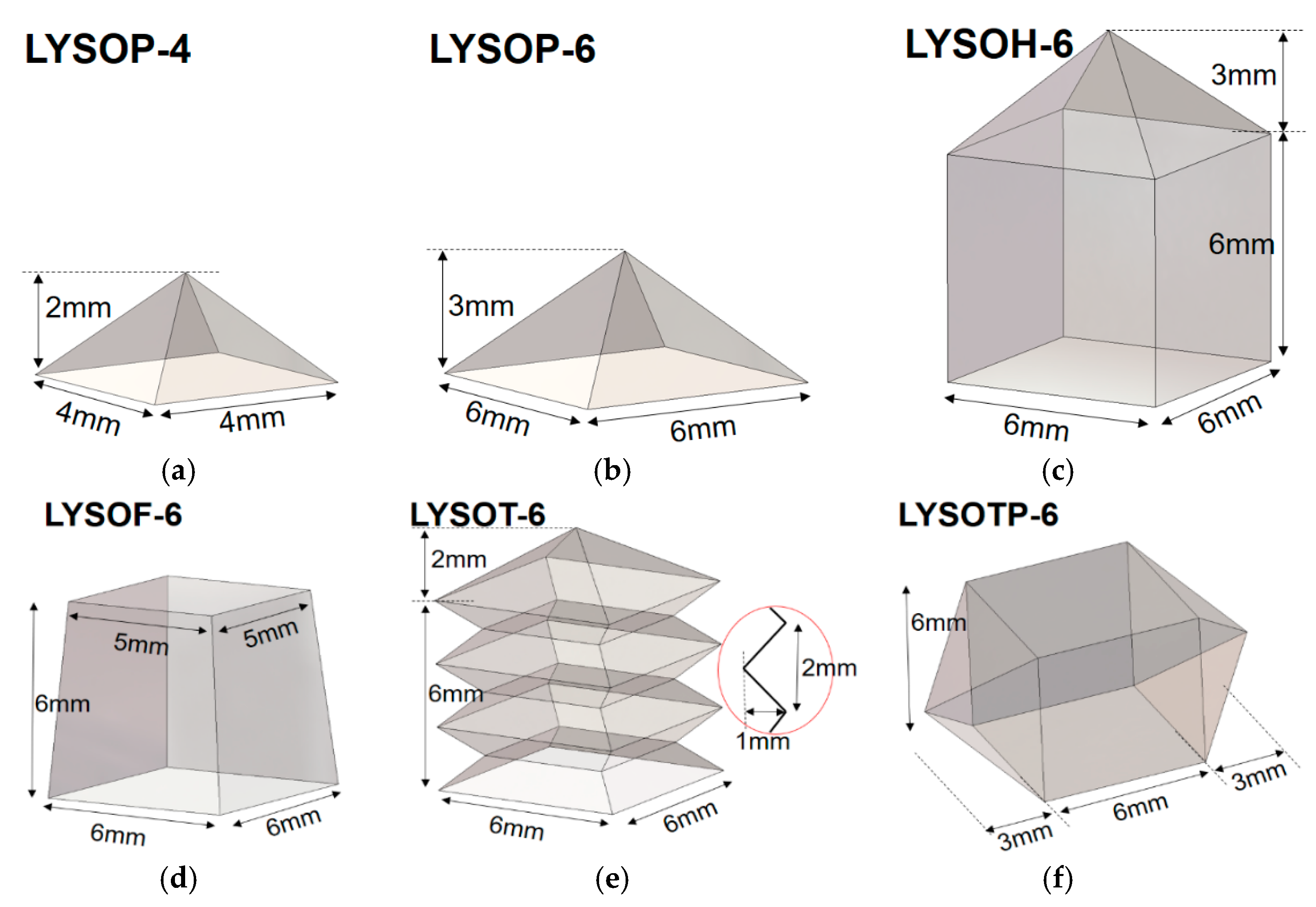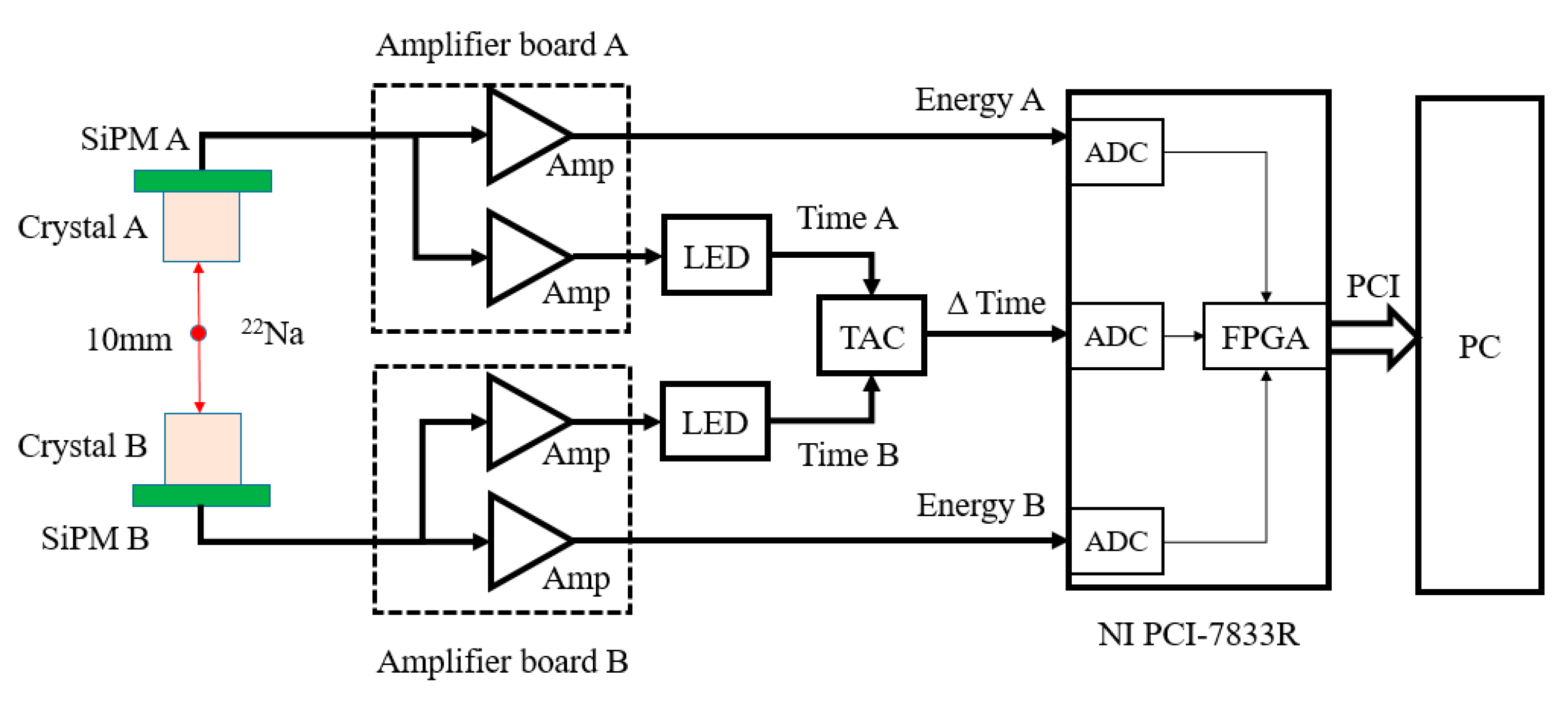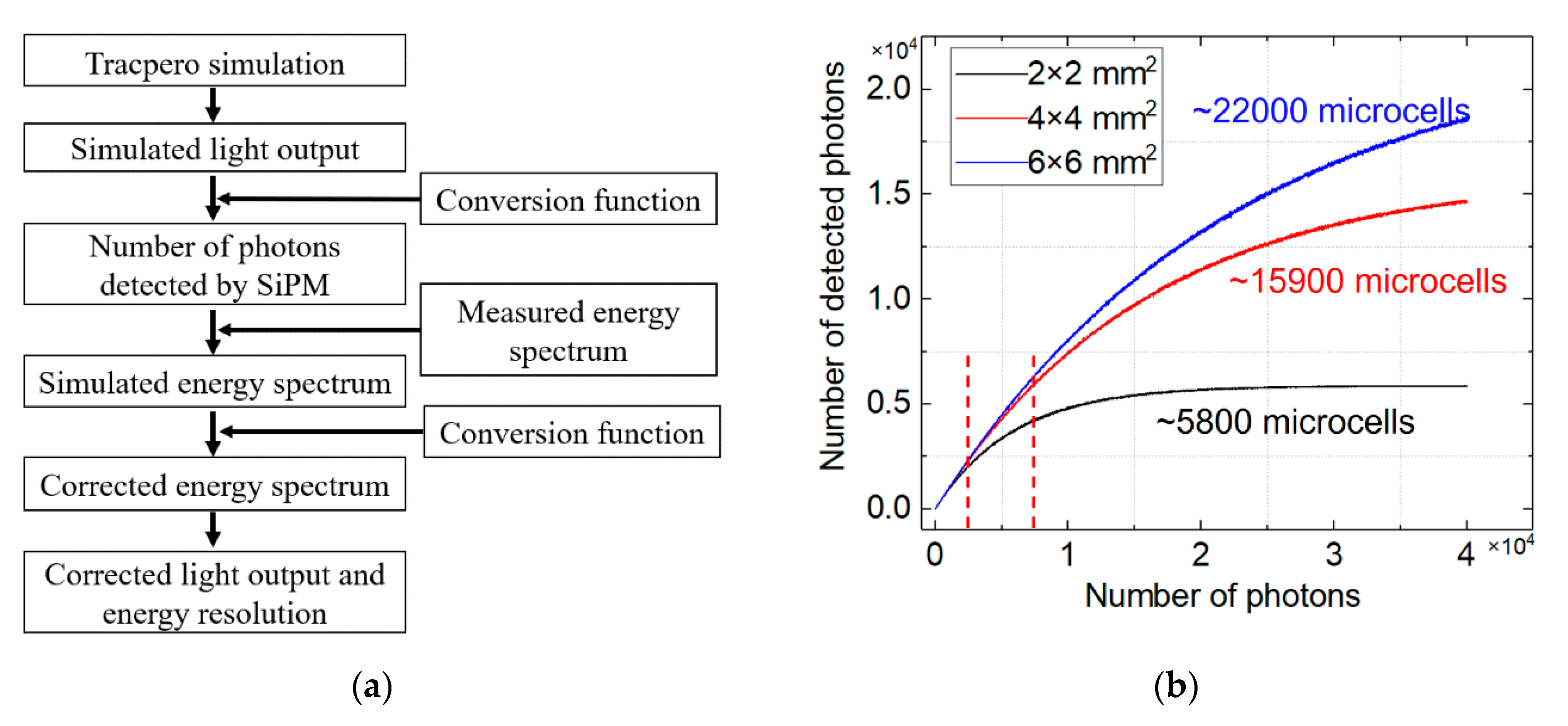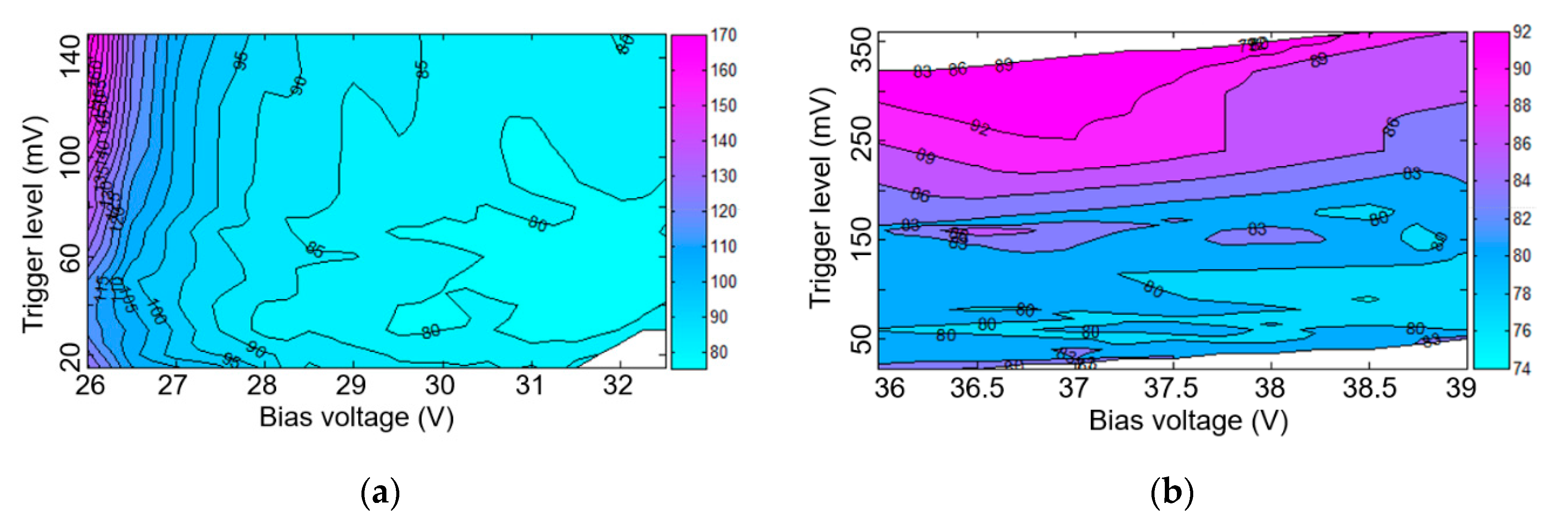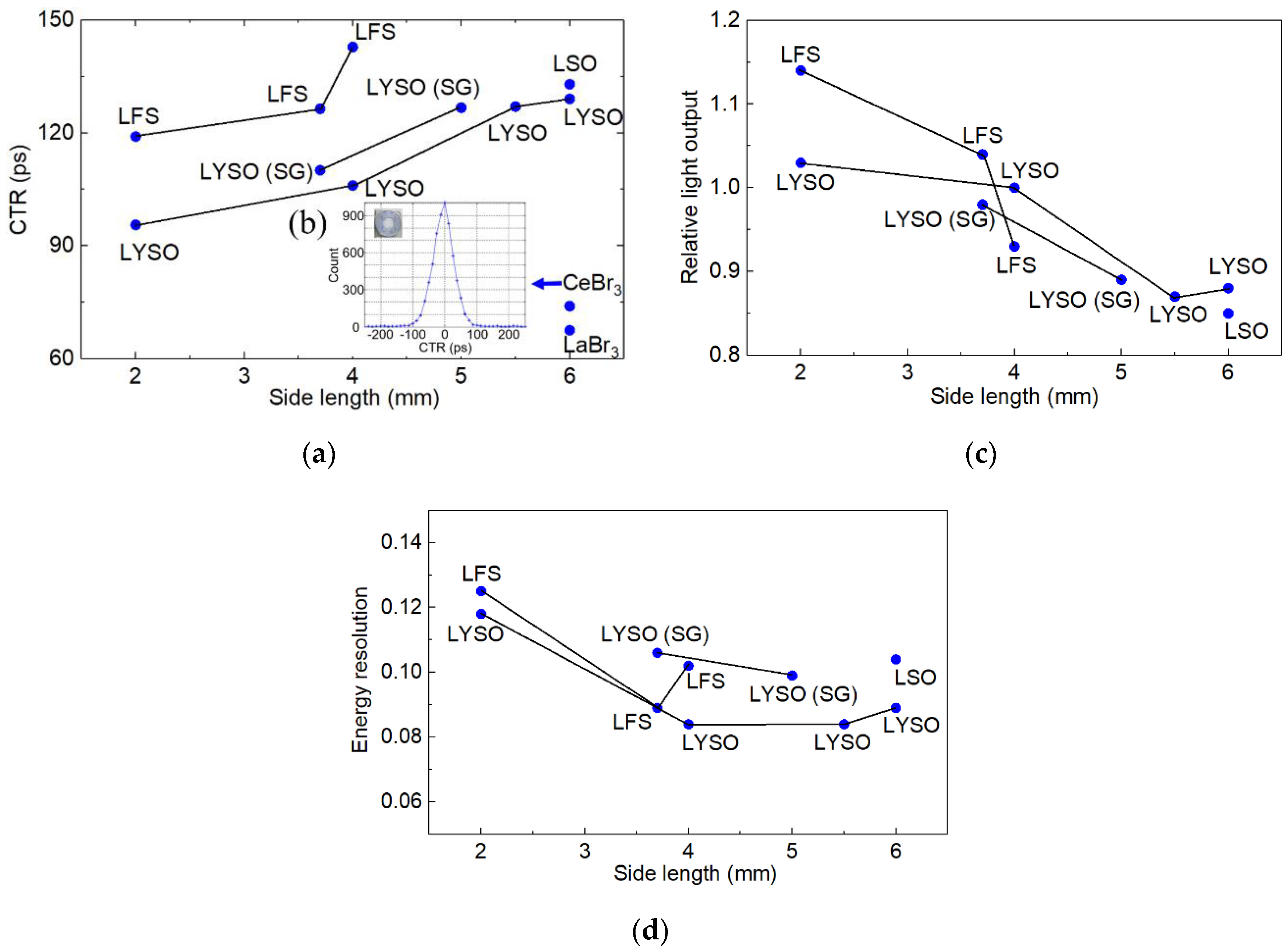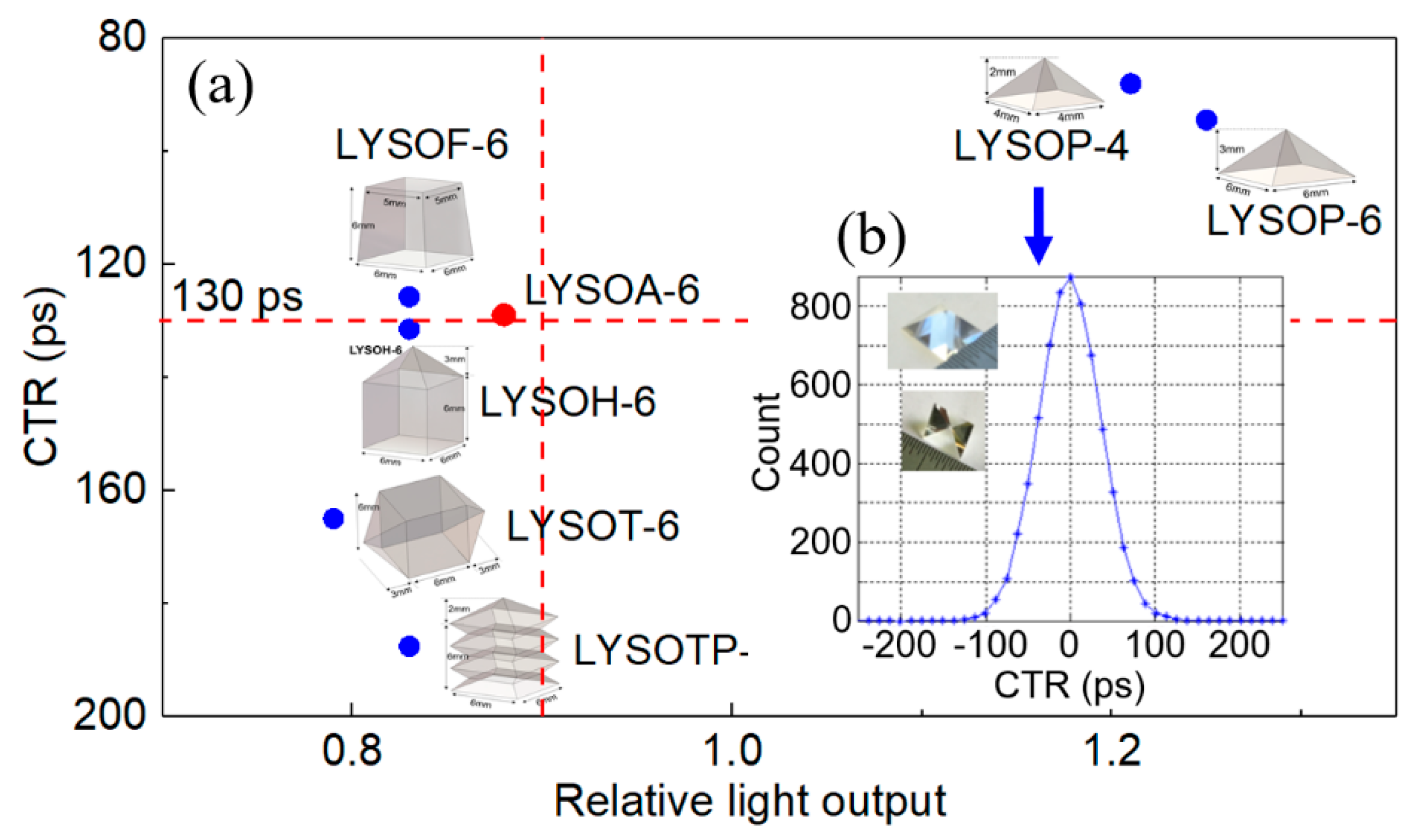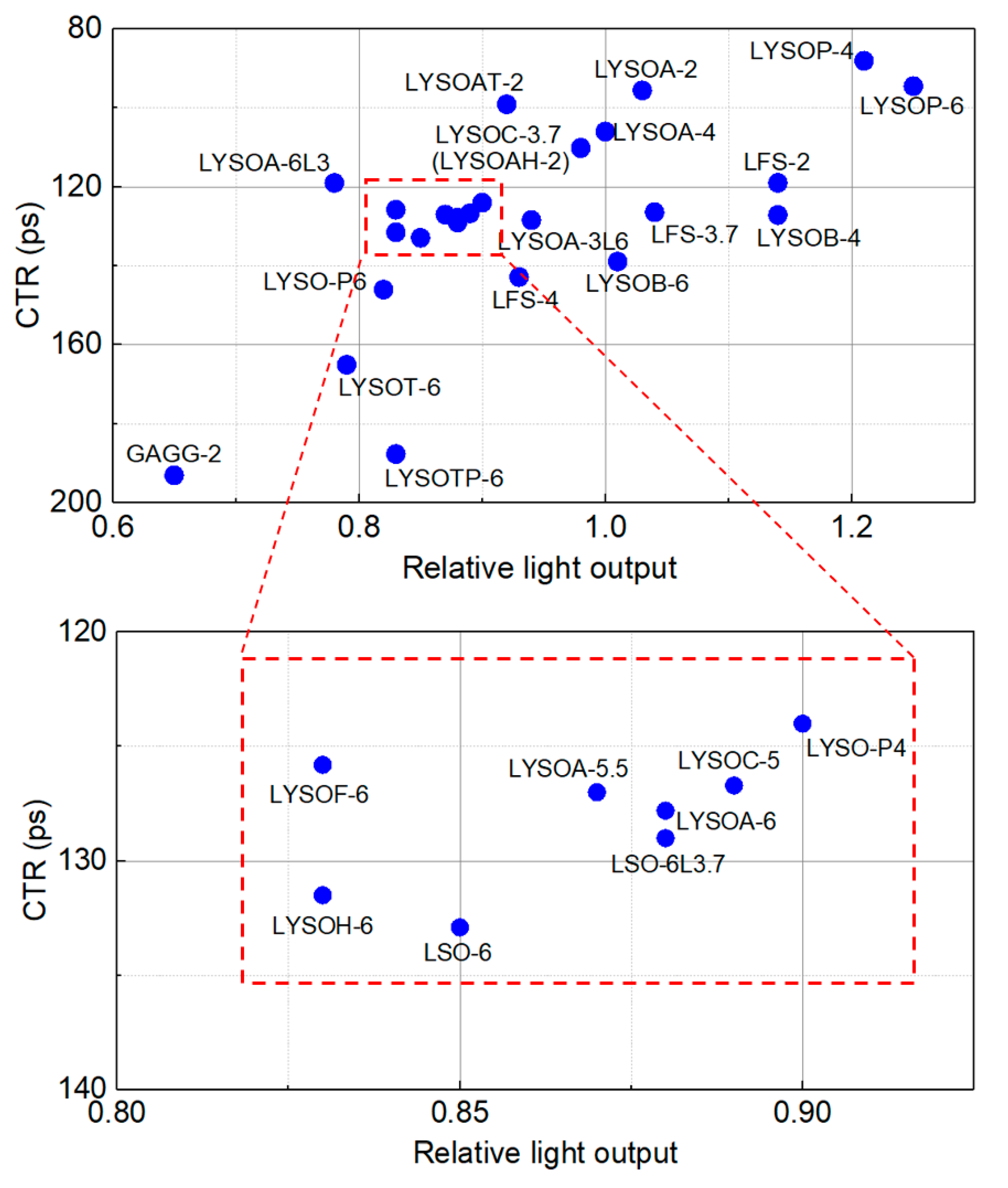1. Introduction
Positron emission tomography (PET) has become commercially available with successful applications in oncology, cardiology and neurology [
1,
2]. The radiation detector is the core component of any PET system; its performance (timing resolution, depth of interaction measurement, light output, decoding accuracy) determines the performance of the PET system [
3,
4,
5,
6]. There are continuous efforts to improve the spatial resolution, sensitivity and signal-to-noise ratio (SNR) in the reconstructed PET images since improvements in these characteristics could significantly facilitate the clinical and preclinical applications of PET imaging [
7,
8,
9,
10,
11,
12].
The SNR in conventional PET images are limited by the sensitivity of the scanner. There are two strategies to improve the sensitivity of a PET scanner. The first strategy is to increase the geometric sensitivity of the scanner by increasing its axial extent to achieve total body coverage [
13,
14,
15,
16]
. This strategy not only improves sensitivity, but it also allows the collection of metabolic and chemical target information simultaneously from multiple organs in the body, such as the brain, lungs, heart, liver and kidneys. The second strategy is to incorporate the additional time-of-flight (TOF) information into the reconstruction to increase the effective sensitivity and SNR in the reconstructed images [
9,
10,
17].
The timing resolution of a PET system is largely determined by the performance of the individual detector modules. Many factors may affect the timing resolution of the detector modules, including the structure of detector [
18,
19,
20,
21,
22], the properties of the scintillator crystal (luminosity and decay time) [
23,
24]; the optical properties (refractive index and optical attenuation length) of the light guides and coupling materials (air, Meltmount
TM, optical glues, etc.) [
25]; the surface treatment of the scintillator crystals and light guides (saw-cutting, chemical etching and mechanical polishing to varying degrees); the optical reflectance properties (specular and/or diffuse reflection and spectral reflection coefficient) of the reflectors (Teflon tapes, ESR films, Lumirror films, Tyvek papers, titanium dioxide paint, multilayer dielectric high-reflector coating, etc.); the electric and optical characteristics of the photon detectors (photon detection efficiency, size and fill factor, etc.) [
26]; and the performance of the readout electronics (bandwidth, slew rate, signal–noise ratio, etc.) [
27,
28]. Photonic crystals can change the propagation path of scintillation photons by adding microstructures on the crystal surface, thus improving the time and energy performance of PET detector [
29].
Enabled by the developments of lutetium oxyorthosilicate (LSO) and lutetium–yttrium oxyorthosilicate (LYSO) scintillators, all three major PET manufacturers have introduced commercial TOF PET cameras that achieve 200~600 ps full-width half-maximum (FWHM) coincidence timing resolution (CTR). Many studies have indicated that a sub-100 ps CTR is achievable. However, there is no literature reported clinic PET systems with a timing resolution better than 200 ps yet.
In order to help break through the barrier, we have performed extensive experimental studies to assess the CTR of PET detectors constructed with samples of different scintillators from different vendors that were fabricated into different shapes with various surface treatments. The basic reasoning of the approach chosen in this study is that the CTR is a function of the photon density detected in the initial moment of an event [
20,
21,
22]. Hence the CTR can be improved through the enhancement of the light collection efficiency by optimizing the geometry and surface treatment of the scintillator. This article not only describes these studies in much greater detail than we previously presented at the IEEE Nuclear Science Symposium and Medical Imaging Conference [
30], but also analyzes the experimental data in depth and compares the performances of the detectors constructed with various scintillator materials, vendors, shapes, surface treatments and silicon photomultipliers systematically. Practical conclusions are drawn, based on the in-depth analyses and the systematic comparisons of the experimental data, to provide a useful guidance to the design of PET detectors with high timing resolution.
2. Materials and Methods
2.1. PET Detector Characterization
2.1.1. Type of Scintillators
Twenty-eight pairs of scintillators with various types, sizes, shapes, surface treatments, and manufacturers were tested for the CTR, light output and energy resolution. Six different types of scintillator cuboids—including LYSO (Suzhou Jtcrystal, JTC), LFS (Zecotek), LSO (Siemens), GAGG (Kinheng), LaBr
3 (Saint Gobain, SG) and CeBr
3 (SG)—with various sizes were tested. The coupling surface of the scintillator cubes was polished and the other surfaces were unpolished. As shown in
Figure 1a, the scintillators were mounted to the center of two SiPMs (MicroFJ-60035-TSV, SensL) with MeltMount optical glue (refractive index: 1.53). The 6 mm LaBr
3 (Saint Gobain, SG) cube and 2 mm GAGG (Kinheng) cubes are shown in
Figure 1b,c. The parameters and labels of those crystals are listed in
Table 1.
2.1.2. Size, Doping and Surface Treatment
Eight pairs of LYSO crystals were tested to study the timing resolutions for different sizes and surface treatments. These “label LYSOA” crystals were made of co-doped LYSO: 0.2% Ce, 0.1% Ca provided by JTC. The parameters of the 4 mm and 6 mm cubes (LYSOA-4 and LYSOA-6) are listed in
Table 1. The parameters of the other six sample LYSOA crystals are listed in
Table 2. Samples LYSOA-2 (
Figure 2 left), LYSOA-4 (
Figure 2 middle), LYSOA-5.5 and LYSOA-6 (
Figure 2 right) were used to compare the timing resolutions of the scintillators of different sized cubes. Samples LYSOA-6 and LYSOA-6L3 were used to compare the timing resolutions of the scintillators of different lengths.
These “sample LYSOB” crystals were made of co-doped LYSO: 0.1% Ce, 0.1% Ca provided by JTC. Samples LYSOA and LYSOB were used to compare the timing resolutions of the scintillators with different-doped values, when comparing crystals with the same shape and size (LYSOA-4 to LYSOB-4, LYSOA-6 to LYSOB-6).Similarly, samples LYSOA-6 (LYSOA-4) and LYSOP-6 (LYSOP-4) were used to compare the timing performance of the crystals of different surface treatments. When testing these 6 mm crystal cubes (LYSOA-6 and LYSOP-6), the bias voltage and trigger level added to the Sensl SiPM ranged from 26 V to 32.5 V and 20 mV to 140 mV, respectively.
2.1.3. Shape
Scintillation crystals were fabricated into different shapes (cubes, cuboids, pyramids and frusta) to investigate the effects of geometric shapes on the detector performance. Cuboid-shaped crystals have the disadvantage of requiring most of the photons to be reflected multiple times before being absorbed by the photodetector, which can reduce timing resolution. Therefore, we also designed and tested some crystals with a pyramid shape. The scintillating photons reflected from the pyramid surface will change their flight angle and emit directly to the coupling surface, which may increase the light output and improve timing resolution. Similarly, scintillating photons in a crystal with a zigzag slope may also be reflected by the slope and directly emit to the coupling surface.
Table 3 shows the parameters of the six odd-shaped scintillation crystals, where LYSOP indicates the pyramid-shaped crystal, LYSOH indicates the crystal with a pyramid-shaped top, LYSOF indicates a frustum-shaped crystal, LYSOT indicates a pyramid-shaped top crystal with a sawtooth surface and LYSOTP indicates the crystals with two pyramids.
Figure 3a,b show the pictures of LYSOF-6, LYSOH-6, LYSOP-4 and LYSOT-6 and LYSOTP-6 crystals, respectively.
Figure 4 shows the design dimensions of various shaped crystals.
2.1.4. Position and Manufacturer
Four pairs of scintillators were tested to investigate differences in boule position and manufacturers. When a crystal is cut from different positions of the scintillator boule, its performance may also be different. Therefore, we tested two 2 mm, 0.2% co-doped LYSO with Ce and Ca crystal cuboids (LYSOAH-2 and LYSOAT-2), which were taken from the tail or head of the same crystal boule.
Finally, sample C crystals were made of LYSO crystal provided by SG. These crystals were used to compare the timing resolution of equivalent LYSO crystals from different manufacturers. The parameters of those crystals are listed in
Table 4.
2.2. Experimental Setting
An experimental system with excellent timing resolution was constructed in this study. As shown in
Figure 5, the system consists of two PET detectors, a Keithley 2400 source meter, two custom-designed amplifier boards, two leading edge discriminators (LEDs), a time-to-amplitude converter (TAC), an NI PCI-7833R board and a PC. Each custom-designed amplifier board split the signal from the SiPM into an energy signal and a timing signal and then amplified them. Two stages of current feedback amplifiers (AD8000, Analog Devices, Inc.) were used to amplify the timing signals with a total gain of 200. The −3 dB bandwidth and the slew rate of the amplifier are 1.5 GHz and 4100 V/μs, respectively. The amplified timing signals were fed to two LEDs (CANBERRA
®, Model 454). Note that the Model 454 is a device with four channels of conventional constant fractional discriminators (CFDs). We have modified its internal circuits and converted the four CFDs into LEDs. The outputs of the LEDs were fed to the TAC (ORTEC
®, Model 566), which measured the time interval between pulses to its start and stop inputs and generated an analog output pulse proportional to the measured time. The full scale of the TAC was set to 50 ns and the FWHM of the timing resolution of the Model 566 TAC was 10 ps for all ranges according to the datasheet. The outputs of the TAC and the amplified energy signals were connected to the NI PCI-7833R board, a PCI-based reconfigurable I/O device with a FPGA and eight analog-to-digital converters on-board.
A LabVIEW program was developed to control the FPGA to perform event triggering and read out the energy and timing signals. The timing resolution of the readout electronics were calibrated with pulses generated from a signal generator. The timing resolution of the readout electronic system was 12.7 ps ± 0.1 ps (mean ± standard deviation), which is only slightly worse than the timing resolution of the Model 566 TAC.
The new high-density (HD) cell SiPM (AdvanSiD) coupled to 6 mm LaBr
3 crystal cubes (
Table 1) was tested at different bias voltages and trigger levels. This is a highly sensitive photon detector in the near-ultraviolet (NUV) and blue light regions. The SiPM size was 6 × 6 mm
2 with 40,000 cells of 20 × 20 μm
2 cell pitch. The bias voltage and trigger level added to the AdvanSiD SiPM ranged from 36 V to 39 V and 10 mV to 350 mV, respectively. The bias voltage and trigger level added to the Sensl SiPM ranged from 26 V to 32.5 V and 20 mV to 140 mV, respectively. The energy spectrum and time spectrum of each experiment were recorded.
Two detectors using identical scintillator crystal configurations were mounted head-to-head with a 10 mm gap with a 22Na point source (Eckert and Ziegler, 0.74 MBq) centrally located between them for coincidence imaging. Unless otherwise stated, the scintillators were wrapped with the same reflector (Teflon tape), coupled with using the same optical glue (MeltMount) with the same pair of SiPMs (6 mm SensL J-series) and tested with the same readout electronics with identical settings in terms of bias voltage (31.5 V), amplifier gain (200) and trigger level (40 mV). Note that we used MeltMount glue to construct the detectors. Thus, we were able to mount and unmount the scintillators conveniently and use the same pair of SiPMs repeatedly.
Approximately one million coincidence events were acquired for each coincidence pair of scintillator crystals within the energy window of 450 keV to 550 keV and were analyzed for the time spectrum and calculation of CTR. The trigger time differs for coincidence events with the same rise time, but different energy peaks. Therefore, the timing measurements were not accurate when the leading-edge discriminator was implemented, especially for the large range of energy windows. Therefore, the energy value of coincidence events was used to correct the time signal. The timing resolution was raised by approximately 10% after compensation. Typically, the FWHM of the peak of the time spectrum was calculated as the timing resolution of the coincidence event.
2.3. Saturation Correction
The saturation correction of SiPMs was applied for all the tested detectors based on Tracepro simulation; the correction process is shown in
Figure 6a. First, the Tracepro was used to optically simulate the interaction of gamma photons in the scintillators, track the scintillation photons and get the simulated light output. The characteristic parameters of those scintillators in the simulation are shown in
Table 5, which was provided by the vendors. The SiPM has different detection efficiency for photons with different wavelength (λ). In the simulation, when λ is 420 nm, the detection efficiency is up to 52%. Depending on the crystal specifications, scintillation photons from 2300 to 7000 (the area between the two red vertical lines) can eventually reach the coupled SiPM.
Second, according to the cross-sectional area of the scintillators, the conversion function between the reached photons number and the detected photons number was obtained through Matlab modeling. The SensL MicroFJ-60035-TSV SiPM has 22,292 microcells.
Figure 6b shows the conversion function curves when the crystal coupling area are 2 × 2 mm
2, 4 × 4 mm
2 and 6 × 6 mm
2, respectively, taking into account of the influence of the thickness of optical glue (0.1 mm) and protective glass (0.35 mm) on SiPM, corresponding coupling microcells are about 5.8 k, 15.9 k and 22 k, respectively. In the simulation, we assume that the scintillating photons simultaneously reach the avalanche diode in the SiPM.
Third, the light output obtained by the Tracepro was converted into the light output actually detected by SiPM through the conversion function. Finally, the uncorrected measured energy spectrum was converted into corrected energy spectrum by matching the peak position of 511 keV with simulated light output. The corrected light outputs and energy resolutions were calculated from the corrected energy spectrum.
3. Results
3.1. Photodetectors
First, we compared the performance of the 6 mm SensL J-series SiPMs (
Figure 7a) with the 6 mm AdvanSiD NUV SiPMs (
Figure 7b) by using a pair of 6 mm LaBr
3 cubes (LaBr-6). The FWHM CTRs were represented by the colors and contour lines. The SensL SiPM without time walk compensation achieved its best coincidence timing resolution of 77 ps FWHM when the bias voltage was 31.5 V and the trigger level was 40 mV. Similarly, the AdvanSiD SiPM without time walk compensation achieved its best CTR of 75 ps FWHM when the bias voltage was 38.5 V and the trigger level was 75 mV. These results showed that the two SiPMs had no significant differences in timing resolution. Therefore, the 6 mm SensL SiPMs were used in all of the tests described below.
3.2. Surface Treatment
LYSO samples LYSOA-6 and LYSOP-6 were used to compare the timing resolution of the crystals of different surface treatments. For these tests, the bias voltage and trigger level added to the SiPM ranged from 26 V to 32.5 V and 20 mV to 140 mV, respectively. The best CTR of the polished crystal was 146 ps with a bias voltage of 31 V and a trigger level of 40 mV (
Figure 8a). The best CTR of the unpolished crystal was 129 ps with a bias voltage of 31.5 V and a trigger level of 40 mV (
Figure 8b).
Clearly, the timing resolution of the unpolished crystal is better than that of the polished crystal, regardless of the bias voltage and the trigger level. When the cubic crystal surface is absolutely smooth, nearly half of the scintillating photons are not received by the SiPM due to total internal reflection (TIR). In contrast, the unpolished surface can change the flight angle of the scintillating photons, thereby breaking the limit of the TIR and increasing the light output and timing resolution.
3.3. Timing and Energy
3.3.1. Type of Scintillators
The cubic crystals listed in
Table 1 and
Table 2 were used to investigate how the CTR varied with the scintillator material. The CTRs of those cubic crystals are shown in
Figure 9a. The timing resolution of the halogen crystal (LaBr-6:77 ps, CeBr-6:74 ps) was the best as shown in
Figure 9b and the GAGG crystal (193 ps) was the worst. The timing resolution of the other crystals were at the same level. In detail, the CTRs of LFS-2, LFS-3.7 and LFS-4 were 119 ps, 126.4 ps and 142.8 ps, respectively, which was worse than those of the 0.2% Ce, 0.1% Ca co-doped LYSO for the same size. The CTRs of LYSO-3.7 (SG), LYSO-5 (SG) and LSO-6 were 110.1 ps, 126.7 ps and 132.9 ps, respectively. In general, the larger the cubic crystal, the worse the timing resolution tends to be. The relative light outputs and energy resolutions of cubic crystals with the same surface treatments are shown in
Figure 9c,d with corrected for saturation effects of SiPMs. The light output of the 4 mm 0.2% co-doped LYSO cubic (LYSOA-4) crystal was used as a reference and it was set to 100%. Similar, the larger the cubic crystal, the worse the light output tend to be.
3.3.2. Size, Doping and Surface Treatment
Figure 10a shows the CTR for the cuboid-shaped LYSO crystals listed in
Table 2. Investigating the size of the crystal cubes, the CTR of the 2 mm cube crystal was better than that of the 6 mm cube crystal and the CTRs of the 4 mm cube crystals were in between (
Figure 10a). In long crystals, the time distribution of the photons (particularly the first photons) reaching the photodetector is wider, due to a larger distribution of the photon pathways. Thus, larger time jitters were introduced in the long crystals. Consistently, the larger the scintillator, the lower the light output (
Figure 10b). The 4 mm cubic crystal achieved the best energy resolution as shown in
Figure 10c.
Investigating the doping and surface treatment, the timing resolution of the 0.2% Ce co-doped LYSO crystals (LYSOA-4 and LYSOA-6) were better than that of the matching 0.1% Ce co-doped LYSO crystals (LYSOB-4 and LYSOB-6). However, the light output of the 0.2% Ce co-doped crystals were lower than that of 0.1% Ce co-doped LYSO crystals. The energy resolution of the 0.2% Ce co-doped LYSO were similar with that of 0.1% Ce co-doped LYSO crystals. In addition, the unpolished 4 mm and 6 mm crystal cubes (LYSOA-4 and LYSOA-6, the black line in
Figure 10a,b) had better light output and timing performance than that of the equivalent polished crystals (LYSOP-4 and LYSOP-6, the red line in
Figure 10a,b).
Investigating the size of the rectangular-prism crystals, the CTRs of LYSOA-6L3, LYSOA-3L6 and LSO-6L3.7 were 119 ps, 128.4 ps and 127.8 ps, respectively. By comparing LYSOA-6L3 and LYSOA-6, it can be inferred that a short crystal length can achieve a better timing resolution when the cross section is the same.
3.3.3. Shape
The CTR and relative light output of six types of odd-shaped 0.2% co-doped LYSO crystals (LYSOH-6, LYSOP-4, LYSOF-6, LYSOP-6, LYSOT-6, LYSOTP-6) are shown in
Figure 11a. The CTR and light output of the LYSOP-4 and LYSOP-6 crystals were better than those of the reference sample LYSOA-6 crystal, which illustrates that the tapered structure may contribute to improve timing resolution and light output. However, the performance of several other odd-shaped crystals (LYSOF-6, LYSOH-6, LYSOT-6, LYSOTP-6) were on the same level as the 6 mm crystal cube. The typical time spectrum of the LYSOP-4 crystal is shown in
Figure 11b.
3.3.4. Position and Manufacturer
Investigating the scintillator manufacturers, the CTRs of the cubic crystals LYSOC-3.7 and LYSOC-5.5 supplied by SG were 110.1 ps and 126.7 ps, respectively. This result confirms that the smaller the crystal cube, the better the timing resolution. The crystal was at the same level as the timing resolution and light output of the crystal provided by JTC.
Investigating the position of the crystal within the boule, the CTRs of LYSOAH-2 and LYSOAT-2 were 110.2 ps and 99.1 ps, respectively. These crystals were taken from different positions of the same crystal boule, which shows that crystal taken from the tail of the crystal boule may achieve a better timing resolution.
4. Summary and Discussion
The CTRs, corrected energy resolution and corrected relative light outputs of the tested scintillator detectors are summarized in
Table 6. The sample CeBr-6 achieved the best CTR (74 ps) and the GAGG-2 crystal achieved the worst CTR (193 ps). The LaBr-6 crystal achieved the best relative light output (1.75) and the GAGG-2 crystal achieved the worst relative light output (0.65). The LaBr-6 crystal achieved the best energy resolution (6.4%) and the LYSOTP-6 crystal achieved the worst energy resolution (12.9%).
Figure 12 shows a comparison of the CTR and the light output for all of test crystals except LaBr-6 and CeBr-6. There is a general trend, that the larger the light output of the crystal, the better the time performance. The timing resolution and light output of several rhenium silicate-based crystals (LYSO, LFS, LFS, etc.) are at the same level.
The CTR of the 2 mm GAGG cubes was 193 ps. However, we note that the SensL SiPM had a much lower photon detection efficiency (PDE) for 530 nm compared to that for 420 nm. Thus, the measured light output from GAGG was 47% lower than that of LYSO. According to the relationship between the CTR and the light output of the crystal, the CTR of the 2 mm GAGG cubes improves to 117 ps if the effect of the low PDE for 530 nm was compensated.
The idea for an odd-shaped crystal came from the study of photonics crystals, which are a kind of micronano structure on the crystal surface that guides and controls the propagation of scintillating photons to increase the light output and time performance of the detector. The macroscopic structure does not meet the expectations, but it is possible when the profiled structure is on the nanometer scale.
In this study, the number of samples for all configurations is small, and some results may not be representative. Especially when the crystals were taken from different positions of the crystal boule (LYSOAH-2 and LYSOAT-2), the difference of CTR may not be as big as tested. The sensitivity of the PET scanners is related to the length of the crystal. In a typical commercial PET scanner, the length of the crystal is approximately 20 mm. It is possible to build a TOF-PET detector with three layers of scintillators. While the detector meets the sensitivity requirements of the PET scanner, the measured CTRs are expected to drop below 70 ps.
5. Conclusions
In summary, we can conclude from the testing results that: (1) a 74 ps FWHM CTR was measured with a pair of 6 mm side CeBr3 cubes. It is possible to achieve a CTR below 50 ps if the PET detector is constructed by smaller LaBr3 crystals; (2) an 88.1 ps FWHM CTR was measured with a pair of 4 mm LYSO: Ce, Ca pyramids, which shows that a change in the shape of the crystal can improve the timing resolution; (3) the two SiPMs from SensL and AdvanSiD have no significant differences with respect to timing resolutions; (4) the crystals with unpolished surfaces have better timing than those with polished surfaces; (5) LYSO: Ce, Ca from different venders and LSO from Siemens have similar performances; (6) 0.2% co-doped LYSO crystals have a better CTR than that of 0.1% Ce co-doped LYSO; (7) 0.2% co-doped LYSO crystals have a better timing resolution than that of LFS; (8) the CTR measurements are related to the size of the crystals. The 2 mm crystals have better timing than 4 mm crystals and the 4 mm crystals have better timing than 6 mm crystals.
The conclusions drawn from these experimental studies provide some practical guidance in terms of the design of PET detectors with high timing resolution. However, many other practical factors, including costs, detector efficiency or stopping power, accuracy of the decoding of the positions of gamma interaction and effects of Compton scatters, need to be considered and carefully balanced, when designing PET detectors for different applications such as the whole-body imaging and the organ-specific imaging.
Author Contributions
Conceptualization, Q.P. and S.X.; methodology, X.Z.; formal analysis, Y.Z.; investigation, G.Y.; data curation, Q.H.; writing—original draft preparation, S.X.; writing—review and editing, J.X.; funding acquisition, Q.P. All authors have read and agreed to the published version of the manuscript.
Funding
This research was funded by National Natural Science Foundation of China (grant number 51627807), the 111 Project (grant number B16019), Hubei International Cooperation Project (grant number 2018AHB001) and the National Institutes of Health, National Institute of Biomedical Imaging and Bioengineering (grant number R01EB006085). The APC was funded by Shenzhen Bay Laboratory.
Conflicts of Interest
The authors declare no conflict of interest.
References
- Hoh, C.K. Clinical use of FDG PET. Nucl. Med. Boil. 2007, 34, 737–742. [Google Scholar] [CrossRef]
- Kitson, S.L.; Cuccurullo, V.; Ciarmiello, A.; Salvo, D.; Mansi, L. Clinical applications of positron emission tomography (PET) imaging in medicine: Oncology, brain diseases and cardiology. Curr. Radiopharm. 2009, 2, 224–253. [Google Scholar] [CrossRef]
- Lamprou, E.; Gonzalez, A.J.; Sanchez, F.; Benlloch, J.M. Exploring TOF capabilities of PET detector blocks based on large monolithic crystals and analog SiPMs. Phys. Med. 2020, 70, 10–18. [Google Scholar] [CrossRef] [PubMed]
- Xie, S.; Zhang, X.; Peng, H.; Yang, J.; Huang, Q.; Xu, J.; Peng, Q. PET detectors with 127 ps CTR for the Tachyon-II time-of-flight PET scanner. Nucl. Instrum. Methods Phys. Res. Sect. A Accel. Spectrom. Detect. Assoc. Equip. 2019, 933, 48–55. [Google Scholar] [CrossRef]
- Alekhin, M.S.; De Haas, J.T.M.; Khodyuk, I.V.; Krämer, K.W.; Menge, P.R.; Ouspenski, V.; Dorenbos, P. Improvement of γ-ray energy resolution of LaBr3: Ce3+ scintillation detectors by Sr2+ and Ca2+ co-doping. Appl. Phys. Lett. 2013, 102, 161915. [Google Scholar] [CrossRef]
- Gundacker, S.; Acerbi, F.; Auffray, E.; Ferri, A.; Gola, A.; Nemallapudi, M.V.; Paternoster, G.; Piemonte, C.; Lecoq, P. State of the art timing in TOF-PET detectors with LuAG, GAGG and L(Y)SO scintillators of various sizes coupled to FBK-SiPMs. J. Instrum. 2016, 11, P08008. [Google Scholar] [CrossRef]
- Conti, M. State of the art and challenges of time-of-flight PET. Phys. Med. 2009, 25, 1–11. [Google Scholar] [CrossRef]
- Moses, W.W. Recent advances and future advances in time-of-flight PET. Nucl. Instrum. Methods Phys. Res. Sect. A Accel. Spectrom. Detect. Assoc. Equip. 2007, 580, 919–924. [Google Scholar] [CrossRef]
- Surti, S.; Karp, J.S. Advances in time-of-flight PET. Phys. Med. 2016, 32, 12–22. [Google Scholar] [CrossRef]
- Conti, M.; Bendriem, B. The new opportunities for high time resolution clinical TOF PET. Clin. Transl. Imaging 2019, 7, 139–147. [Google Scholar] [CrossRef]
- Hsu, D.F.C.; Ilan, E.; Peterson, W.T.; Uribe, J.; Lubberink, M.; Levin, C.S. Studies of a next-generation silicon-photomultiplier–based time-of-flight PET/CT system. J. Nucl. Med. 2017, 58, 1511–1518. [Google Scholar] [CrossRef] [PubMed]
- Vandenberghe, S. [I180] Recent developments in time-of-flight PET. Phys. Med. Eur. J. Med. Phys. 2018, 52, 69. [Google Scholar] [CrossRef]
- Lyu, Y.; Lv, X.; Liu, W.; Judenhofer, M.S.; Zwingenberger, A.; Wisner, E.R.; Berg, E.; McKenney, S.E.; Leung, E.K.; Spencer, B.A.; et al. Mini EXPLORER II: A prototype high-sensitivity PET/CT scanner for companion animal whole body and human brain scanning. Phys. Med. Boil. 2019, 64, 075004. [Google Scholar] [CrossRef]
- Zhang, X.; Zhou, J.; Cherry, S.R.; Badawi, R.D.; Qi, J. Quantitative image reconstruction for total-body PET imaging using the 2-meter long EXPLORER scanner. Phys. Med. Boil. 2017, 62, 2465–2485. [Google Scholar] [CrossRef]
- Badawi, R.D.; Shi, H.; Hu, P.; Chen, S.; Xu, T.; Price, P.M.; Ding, Y.; Spencer, B.A.; Nardo, L.; Liu, W.; et al. First human imaging studies with the EXPLORER total-body PET scanner. J. Nucl. Med. 2019, 60, 299–303. [Google Scholar] [CrossRef]
- Cherry, S.R.; Jones, T.; Karp, J.S.; Qi, J.; Moses, W.W.; Badawi, R.D. Total-body PET: Maximizing sensitivity to create new opportunities for clinical research and patient care. J. Nucl. Med. 2017, 59, 3–12. [Google Scholar] [CrossRef]
- Lecoq, P. Pushing the limits in time-of-flight PET imaging. IEEE Trans. Radiat. Plasma Med. Sci. 2017, 1, 473–485. [Google Scholar] [CrossRef]
- Guo, L.; Tian, J.; Chen, P.; Derenzo, S.E.; Choong, W.-S. Improving timing performance of double-ended readout in TOF-PET detectors. J. Instrum. 2020, 15, P01003. [Google Scholar] [CrossRef]
- Gundacker, S.; Knapitsch, A.; Auffray, E.; Jarron, P.; Meyer, T.; Lecoq, P. Time resolution deterioration with increasing crystal length in a TOF-PET system. Nucl. Instrum. Methods Phys. Res. Sect. A Accel. Spectrom. Detect. Assoc. Equip. 2014, 737, 92–100. [Google Scholar] [CrossRef]
- Carrier, C.; LeComte, R. Effect of geometrical modifications and crystal defects on light collection in ideal rectangular parallelepipedic BGO scintillators. Nucl. Instrum. Methods Phys. Res. Sect. A Accel. Spectrom. Detect. Assoc. Equip. 1990, 294, 355–364. [Google Scholar] [CrossRef]
- Huber, J.S.; Moses, W.W.; Andreaco, M.S.; Loope, M.; Melcher, C.L.; Nutt, R. Geometry and surface treatment dependence of the light collection from LSO crystals. Nucl. Instrum. Methods Phys. Res. Sect. A Accel. Spectrom. Detect. Assoc. Equip. 1999, 437, 374–380. [Google Scholar] [CrossRef]
- Danevich, F.A.; Kobychev, V.V.; Kobychev, R.V.; Kraus, H.; Mikhailik, V.B.; Mokina, V.M.; Solsky, I.M. Impact of geometry on light collection efficiency of scintillation detectors for cryogenic rare event searches. Nucl. Instrum. Methods Phys. Res. Sect. B Beam Interact. Mater. At. 2014, 336, 26–30. [Google Scholar] [CrossRef]
- Chen, J.; Mao, R.; Zhang, L.; Zhu, R.-Y. Large size LSO and LYSO crystals for future high energy physics experiments. IEEE Trans. Nucl. Sci. 2007, 54, 718–724. [Google Scholar] [CrossRef]
- Mao, R.; Zhang, L.; Zhu, R.-Y. Optical and scintillation properties of inorganic scintillators in high energy physics. IEEE Trans. Nucl. Sci. 2008, 55, 2425–2431. [Google Scholar] [CrossRef]
- Janecek, M.; Moses, W.W. Measuring light reflectance of BGO crystal surfaces. EEE Trans. Nucl. Sci. 2008, 55, 2443–2449. [Google Scholar] [CrossRef]
- Wagatsuma, K.; Miwa, K.; Sakata, M.; Oda, K.; Ono, H.; Kameyama, M.; Toyohara, J.; Ishii, K. Comparison between new-generation SiPM-based and conventional PMT-based TOF-PET/CT. Phys. Med. 2017, 42, 203–210. [Google Scholar] [CrossRef]
- Sui, T.; Zhao, Z.; Xie, S.; Xie, Y.; Zhao, Y.; Huang, Q.; Xu, J.; Peng, Q. A 2.3-ps RMS Resolution Time-to-Digital Converter Implemented in a Low-Cost Cyclone V FPGA. IEEE Trans. Instrum. Meas. 2019, 68, 3647–3660. [Google Scholar] [CrossRef]
- Song, Z.; Zhao, Z.; Yu, H.; Yang, J.; Zhang, X.; Sui, T.; Xu, J.; Xie, S.; Huang, Q.; Peng, Q. An 8.8 ps RMS Resolution Time-To-Digital Converter Implemented in a 60 nm FPGA with Real-Time Temperature Correction. Sensors 2020, 20, 2172. [Google Scholar] [CrossRef]
- Salomoni, M.; Pots, R.; Auffray, E.; Lecoq, P. Enhancing light extraction of inorganic scintillators using photonic crystals. Crystals 2018, 8, 78. [Google Scholar] [CrossRef]
- Peng, Q.; Xie, S.; Sui, T.; Yang, M.; Huang, Q.; Xu, J. Experimental assessments of the timing performances of detectors constructed with LaBr3, CeBr3, LFS, LSO, LYSO, GAGG scintillators. In Proceedings of the 2017 IEEE Nuclear Science Symposium and Medical Imaging Conference (NSS/MIC), Atlanta, GA, USA, 21–28 October 2017; pp. 1–2. [Google Scholar]
Figure 1.
(a) Silicon photomultipliers (SiPMs) and scintillators; (b) packaged 6 mm LaBr3 cubes (LaBr-6) crystals; (c) GAGG-2 crystals.
Figure 1.
(a) Silicon photomultipliers (SiPMs) and scintillators; (b) packaged 6 mm LaBr3 cubes (LaBr-6) crystals; (c) GAGG-2 crystals.
Figure 2.
LYSO cubes with sizes of 2 × 2 × 2 mm3 (left), 4 × 4 × 4 mm3 (middle) and 6 × 6 × 6 mm3 (right).
Figure 2.
LYSO cubes with sizes of 2 × 2 × 2 mm3 (left), 4 × 4 × 4 mm3 (middle) and 6 × 6 × 6 mm3 (right).
Figure 3.
(a) LYSOF-6 (left), LYSOH-6 (middle) and LYSOP-4 (right) crystals; (b) LYSOT-6 (left) and LYSOTP-6 (right) crystals.
Figure 3.
(a) LYSOF-6 (left), LYSOH-6 (middle) and LYSOP-4 (right) crystals; (b) LYSOT-6 (left) and LYSOTP-6 (right) crystals.
Figure 4.
Shape and size of the odd-shaped scintillator configurations. (a) LYSOP-4 crystal, (b) LYSOP-6 crystal, (c) LYSOH-6 crystal, (d) LYSOF-6 crystal, (e) LYSOT-6 crystal and (f) LYSOTP-6 crystal.
Figure 4.
Shape and size of the odd-shaped scintillator configurations. (a) LYSOP-4 crystal, (b) LYSOP-6 crystal, (c) LYSOH-6 crystal, (d) LYSOF-6 crystal, (e) LYSOT-6 crystal and (f) LYSOTP-6 crystal.
Figure 5.
Schematic of the experimental setup with readout electronics.
Figure 5.
Schematic of the experimental setup with readout electronics.
Figure 6.
(a) Flowchart of the saturation correction; (b) conversion function.
Figure 6.
(a) Flowchart of the saturation correction; (b) conversion function.
Figure 7.
Contour plots of the FWHM CTR. (a) SensL J-series SiPMs; (b) AdvanSiD NUV HD SiPMs.
Figure 7.
Contour plots of the FWHM CTR. (a) SensL J-series SiPMs; (b) AdvanSiD NUV HD SiPMs.
Figure 8.
Contour plots of the FWHM CTR of 0.2% co-doped LYSO. (a) Polished crystal; (b) unpolished crystal.
Figure 8.
Contour plots of the FWHM CTR of 0.2% co-doped LYSO. (a) Polished crystal; (b) unpolished crystal.
Figure 9.
(a) CTR values, (b) time spectrum of the 6 mm CeBr3 cube; (c) relative light outputs and (d) energy resolutions of cubic crystal.
Figure 9.
(a) CTR values, (b) time spectrum of the 6 mm CeBr3 cube; (c) relative light outputs and (d) energy resolutions of cubic crystal.
Figure 10.
(a) CTRs, (b) relative light outputs and (c) energy resolutions of 2 mm, 4 mm and 6 mm side LYSO cubes crystal.
Figure 10.
(a) CTRs, (b) relative light outputs and (c) energy resolutions of 2 mm, 4 mm and 6 mm side LYSO cubes crystal.
Figure 11.
(a) CTR and the relative light output of six types of odd crystals (blue points); (b) time spectrum of LYSOP-4.
Figure 11.
(a) CTR and the relative light output of six types of odd crystals (blue points); (b) time spectrum of LYSOP-4.
Figure 12.
Comparison of the CTR and corrected light output for tested crystals.
Figure 12.
Comparison of the CTR and corrected light output for tested crystals.
Table 1.
Parameters of the lutetium–yttrium oxyorthosilicate (LYSO), lutetium oxyorthosilicate (LSO), LFS, GAGG, LaBr3 and CeBr3 crystals.
Table 1.
Parameters of the lutetium–yttrium oxyorthosilicate (LYSO), lutetium oxyorthosilicate (LSO), LFS, GAGG, LaBr3 and CeBr3 crystals.
| No. | Labels | Crystal | Size (mm)
(L × W × H) | Surface Treatment of Uncoupled Surfaces |
|---|
| 01 | LYSOA-4 | LYSO: 0.2% Ce, 0.1% Ca co-doped | 4 × 4 × 4 | Unpolished |
| 02 | LYSOA-6 | 6 × 6 × 6 |
| 03 | LSO-6L3.7 | LSO | 6 × 6 × 3.7 |
| 04 | LSO-6 | 6 × 6 × 6 |
| 05 | LFS-2 | LFS | 2 × 2 × 2 |
| 06 | LFS-3.7 | 3.7 × 3.7 × 3.7 |
| 07 | LFS-4 | 4 × 4 × 4 |
| 08 | GAGG-2 | GAGG | 2 × 2 × 2 |
| 09 | LaBr-6 | LaBr3 | 6 × 6 × 6 |
| 10 | CeBr-6 | CeBr3 | 6 × 6 × 6 |
Table 2.
Parameters of the LYSO cube crystals.
Table 2.
Parameters of the LYSO cube crystals.
| No. | Label | Crystal | Size (mm)
(L × W × H) | Surface Treatment of Uncoupled Surfaces |
|---|
| 01 | LYSOA-2 | LYSO: 0.2% Ce, 0.1% Ca co-doped (JTC) | 2 × 2 × 2 | Unpolished |
| 02 | LYSOA-5.5 | 5.5 × 5.5 × 5.5 |
| 03 | LYSOA-6L3 | 6 × 6 × 3 |
| 04 | LYSOA-3L6 | 3 × 3 × 6 |
| 05 | LYSOB-4 | LYSO: 0.1% Ce, 0.1% Ca co-doped (JTC) | 4 × 4 × 4 |
| 06 | LYSOB-6 | 6 × 6 × 6 |
| 07 | LYSOP-4 | LYSO: 0.2% Ce, 0.1% Ca co-doped (JTC) | 4 × 4 × 4 | Polished |
| 08 | LYSOP-6 | 6 × 6 × 6 |
Table 3.
Parameters of the odd-shaped LYSO crystals.
Table 3.
Parameters of the odd-shaped LYSO crystals.
Table 4.
Parameters of the LYSO taken from different positions of the crystal boule.
Table 4.
Parameters of the LYSO taken from different positions of the crystal boule.
| No. | Label | Crystal | Size (mm)
(L × W × H) | Surface Treatment of Uncoupled Surfaces |
|---|
| 01 | LYSOAH-2 | 0.2% Ce co-doped LYSO (from head boule) | 2 × 2 × 2 | Unpolished |
| 02 | LYSOAT-2 | 0.2% Ce co-doped LYSO (from tail boule) |
| 03 | LYSOC-3.7 | LYSO crystal (SG) | 3.7 × 3.7 × 3.7 |
| 04 | LYSOC-5 | 5 × 5 × 5 |
Table 5.
Characteristic parameters of the tested crystals.
Table 5.
Characteristic parameters of the tested crystals.
| Crystal | Peak Emission Wavelength (nm) | Refractive Index | Decay Time (ns) | Absolute Light Output
(103 Photon/MeV) |
|---|
| 0.2% co-doped LYSO | 420 | 1.82 | 35 | 32 |
| 0.1% co-doped LYSO | 420 | 1.82 | 41 | 39 |
| LFS | 420 | 1.82 | 35 | 38 |
| LSO | 420 | 1.82 | 40 | 30 |
| GAGG | 530 | 1.9 | 50 | 32 |
| LaBr3 | 370 | 1.9 | 16 | 60 |
| CeBr3 | 380 | 1.9 | 17 | 68 |
Table 6.
Testing results of all the scintillator detectors.
Table 6.
Testing results of all the scintillator detectors.
| No. | Label | Surface Treatment | Cube Size (mm)
(L × W× H) | Energy Resolution | Relative Light Output | CTR (ps) |
|---|
| 1 | LYSOA-4 | Unpolished | 4 × 4 × 4 | 8.4% | 1 | 106 |
| 2 | LYSOA-6 | 6 × 6 × 6 | 8.9% | 0.88 | 129 |
| 3 | LSO-6L3.7 | 6 × 6 × 3.7 | 10.7% | 0.88 | 127.8 |
| 4 | LSO-6 | 6 × 6 × 6 | 10.4% | 0.85 | 132.9 |
| 5 | LFS-2 | 2 × 2 × 2 | 12.5% | 1.14 | 119 |
| 6 | LFS-3.7 | 3.7 × 3.7 × 3.7 | 8.9% | 1.04 | 126.4 |
| 7 | LFS-4 | 4 × 4 × 4 | 10.2% | 0.93 | 142.8 |
| 8 | GAGG-2 | 2 × 2 × 2 | 10.7% | 0.65 | 193 |
| 9 | LaBr-6 | 6 × 6 × 6 | 6.4% | 1.75 | 77 |
| 10 | CeBr-6 | 6 × 6 × 6 | NA | NA | 74 |
| 11 | LYSOA-2 | Unpolished | 2 × 2 × 2 | 11.8% | 1.03 | 95.6 |
| 12 | LYSOA-5.5 | 5.5 × 5.5 × 5.5 | 8.4% | 0.87 | 127 |
| 13 | LYSOA-6L3 | 6 × 6 × 3 | 9.8% | 0.78 | 119 |
| 14 | LYSOA-3L6 | 3 × 3 × 6 | 9.5% | 0.94 | 128.4 |
| 15 | LYSOB-4 | 4 × 4 × 4 | 8.7% | 1.14 | 127.1 |
| 16 | LYSOB-6 | 6 × 6 × 6 | 9.7% | 1.01 | 138.9 |
| 17 | LYSO-P4 | Polished | 4 × 4 × 4 | 7.8% | 0.90 | 124 |
| 18 | LYSO-P6 | 6 × 6 × 6 | 8.3% | 0.82 | 146 |
| 19 | LYSOP-4 | Polished | Figure 4a | 7.6% | 1.21 | 88.1 |
| 20 | LYSOP-6 | Figure 4b | 7.7% | 1.25 | 94.5 |
| 21 | LYSOH-6 | Figure 4c | 10.8% | 0.83 | 131.5 |
| 22 | LYSOF-6 | Figure 4d | 11.2% | 0.83 | 125.8 |
| 23 | LYSOT-6 | Figure 4e | 10.6% | 0.79 | 165 |
| 24 | LYSOTP-6 | Figure 4f | 12.9% | 0.83 | 187.6 |
| 25 | LYSOAH-2 | Unpolished | 2 × 2 × 2 | 12.2% | 0.98 | 110.2 |
| 26 | LYSOAT-2 | 2 × 2 × 2 | 12.9% | 0.92 | 99.1 |
| 27 | LYSOC-3.7 | 3.7 × 3.7 × 3.7 | 10.6% | 0.98 | 110.1 |
| 28 | LYSOC-5 | 5 × 5 × 5 | 9.9% | 0.89 | 126.7 |
© 2020 by the authors. Licensee MDPI, Basel, Switzerland. This article is an open access article distributed under the terms and conditions of the Creative Commons Attribution (CC BY) license (http://creativecommons.org/licenses/by/4.0/).

